Have you hit the wall yet? That wall where you realize if something doesn’t change with your current schedule and responsibilities, you’re not going to be able to keep going at your current speed? It often happens when communication piles up, you forget to pick your kid up from school, or you miss an important meeting. At least, it did for me when I sat down and really quantified how I spend my time. The results were interesting. The majority of my day is spent in my inbox. Why then do I feel like I’m NEVER caught up and everyone keeps asking me, “Hey, did you get that e-mail?”
I get really angry when I see people tweeting “w00t, inbox zero, p0wned that!” I went a step further to see if I was simply the world’s worst e-mail responder, or if there was something else at play. What I discovered after I did some data crunching was that my inbox has a daily average of 42 e-mails that require a legitimate response. That number doesn’t include spam, junk, or newsletters! That’s 42 e-mails that require thought, probably some research, an action, or communication with others. Some e-mails might be answered in under a minute from click to read to response and send. Others might take much longer. Add those to my existing responsibilities and it’s a lot.
How do I scale ME?
OPERATIONS
1. Hire the Right Team
This could be an entire post, but for now, here are the bullet points:
- Always be hiring
- Hire for culture
- Empower your team
- Clearly define your vision
- Give them the tools they need to succeed
2. Create a System of Accountability
Standing meetings
Meetings can be a major time suck if you don’t stay on task and have productive conversations. Mark Menard and his team of local Ruby on Rails developers hold daily standing meetings to keep everyone literally on their toes. We recently started doing this, and it goes a long way towards keeping everyone focused and accountable to each other for deliverables.
3. Turn Everything Off
There’s a lot of research coming out on what the Internet is doing to our attention spans. In light of these discoveries, have we changed our work patterns? For most of us, the answer is probably no. Our world is full of push notifications, text messages, social media alerts, phone calls, e-mails, Skype messages, and my biggest frustration–Google+ numbers in the upper right corner of my e-mail.
Everyone seems to have instant access to me (and probably you). Is that helping us get through our highest value work? For me, the answer was no. Here’s how I unplug:
- Schedule time on your calendar to unplug
- Tell others what you’re doing so they know not to disturb you unless there’s a fire
- Close the door or put on your headphones
- Put your phone on silent
- Close out of anything that forces an alert, sound, or other notification
- Take a deep breath and dive in
- When you’ve completed your task, let everyone know you’re back online
SKYPE
4. Use your notification settings
In the office, we use Skype to communicate with the team. Sometimes group chats can get very off-topic and the last thing I need to focus on is who is craving ice cream. To counteract this, I set up notification settings and told the team about them. Now they know that if they need to get hold of me in a group chat (vs. individual chats where my settings were left normal), they can simply type “Rhea” or “OSM” and I’ll get a notification.
- Right click on a conversation and select “notification settings”
- Select “notify me only if these words are mentioned:”
- Enter your name or whatever agreed-upon group ID will be used
- Select “OK” and enjoy having conversations again on your terms
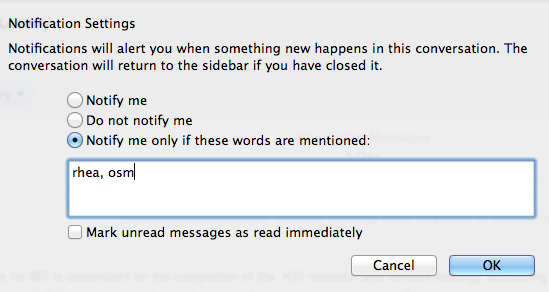
5. Prioritize unread messages first
Michelle instructed our team to do this for link outreach. It helps everyone catch priorities. At first, I didn’t like it, so went back to seeing everything at once. Then I recognized why I didn’t succeed the first time–I would open an e-mail, read it, and not have an answer, so I’d click out of the e-mail, but not add an action to it. I assumed that I would remember, because I’m smart, but I’m also human so invariably, I did not remember. Now I’ve made a simple rule for myself–if I can’t respond to an e-mail in that moment, it stays “unread” until I have what I need to respond. This may sound incredibly simple, but it works. You could also use labels and filters to step up your organization, but be careful! Too many labels and filters and you might miss something important.
- If you use Gmail, go to your settings
- Select the “Inbox” tab
- Select “Inbox type:”
![]()
6. Display a Snippet of the E-mail
Recently, I was away from the office for about ten days of conference travel, and noticed that even though I was traveling, I tackled far more e-mails than usual. Why was that? It occurred to me that my phone was set up to display a snippet of the e-mail. This gave me a quick look at the content of the e-mail, so by the time I finished reading the subject line, I’d also read the first part of the e-mail. Let’s be honest, how often do you see an e-mail and recognize that you probably don’t have time to respond to it right then, so you ignore it until you do? By viewing a quick snippet, I will often be surprised by how simple a response may be versus anticipating a bigger problem.
- If you use Gmail, go to your settings
- Select the “General” tab
- Select “Snippets”:
![]()
7. Set up Canned Responses
How often do you have to send the same e-mail to someone, or a variation of it? Rather than typing the same message over and over again, use Gmail’s canned responses in Labs:
- If you use Gmail, go to your settings
- Select the “Labs” tab
- Search for “Canned Responses by Chad P”
- Select “Enable”
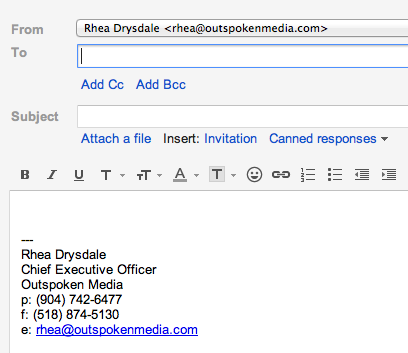
Now when you compose an e-mail, a new area for “canned responses” will appear, and you can insert, save, and delete responses as needed.
PHONE
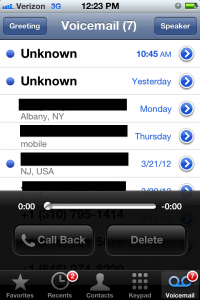 8. Make Voicemail Management Easier
8. Make Voicemail Management Easier
This is the feature that would have sold me on the iPhone faster than any other, but no one told me about it! Nothing made me want to hide from voicemails faster than my Blackberry because there was no simple way to get to a particular message.
With iPhone’s voice-mail interface, I can navigate quickly to a specific voicemail, see the contact associated with it, and use the scroll bar to fast forward or rewind to hear their phone number again. And, if I delete a message, there’s an archive that forces a double deletion, so I can reclaim a message if I mistakenly got rid of it.
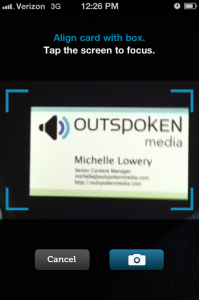 9. Stop Collecting Business Cards; Use cardmunch
9. Stop Collecting Business Cards; Use cardmunch
This iPhone app makes it simple to scan a business card, save it, sync with a contact, and find someone on LinkedIn. Just take a snapshot of the card and wait a few minutes. Soon, magical fairies will transcribe the card’s information as a business contact. If the contact has an account on LinkedIn, they’ll associate it with the contact information. Now, when I go to conferences, I snap cards instantly with the app rather than returning home with a pile of cards that eventually get tossed with the receipts my accountant really wanted me to save.
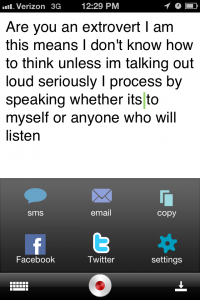 10. Dragon Dictation
10. Dragon Dictation
Are you an extrovert? I am!
This means I don’t know how to think unless I’m talking out loud. Seriously. I process by speaking whether it’s to myself or anyone who will listen. You don’t even have to respond, just let me go! ;)
Dragon Dictation means I can talk through some things and quickly see those thoughts in writing. Then I transfer my notes to Evernote because I probably just rambled an awful rough draft while driving somewhere or cooking dinner.
TECHNOLOGY
Claye Stokes just wrote a solid post for Raven on tools to use to increase customer service. Rather than reinventing the wheel, I recommend you check it out. Dave Snyder wrote a similar post years ago on tools for entrepreneurs that always stuck out in my head.
That’s it from me. What are your favorite hacks or tips for increased productivity? It’s a subject that never gets old, because we can always be doing more!
